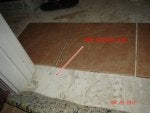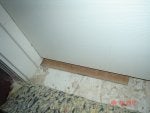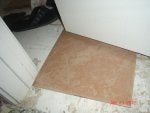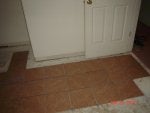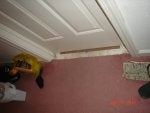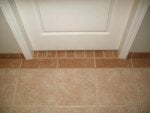At an entry to a room, where do you place the floor tile? It is recommended to center the tile across the width of the opening, but where do you start the full tile.
There are two options.
Option 1:
Start right at the door, so when you close the door, the tile is right at the edge. This will require to cut tiles along the wall to the left of the door (as viewed from the photo).
Option 2:
Start at the wall depth. This will not require any cuts to the tile along the wall to the left (except for the wall being not squared).
A transition strip can be put in between the room and the hallway so I would think either option would work. I just don't know if there are any disadvantages to doing options 2 since the transition strip my be bigger than normal.
I haven't decided if I will lay tile (a different tile than the room), or lay carpet in the area outside the doorway.
There are two options.
Option 1:
Start right at the door, so when you close the door, the tile is right at the edge. This will require to cut tiles along the wall to the left of the door (as viewed from the photo).
Option 2:
Start at the wall depth. This will not require any cuts to the tile along the wall to the left (except for the wall being not squared).
A transition strip can be put in between the room and the hallway so I would think either option would work. I just don't know if there are any disadvantages to doing options 2 since the transition strip my be bigger than normal.
I haven't decided if I will lay tile (a different tile than the room), or lay carpet in the area outside the doorway.


